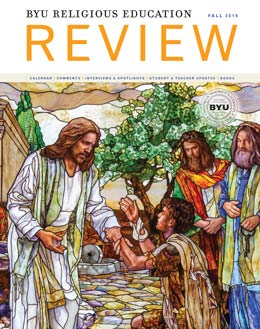The Gospels in Glass
Religious Education’s Role in Creating Tom Holdman’s Window in the Rome Temple Visitors’ Center
Brad Wilcox, Anthony Sweat, and Brent R. Nordgren
Brad Wilcox (brad_wilcox@byu.edu) was an associate professor of ancient scripture at BYU when this was published.
Anthony Sweat (anthony_sweat@byu.edu) was an associate professor of Church history and doctrine at BYU when this was published.
Brent R. Nordgren (brent_nordgren@byu.edu) was the managing editor of the BYU Religious Education Review when this was published
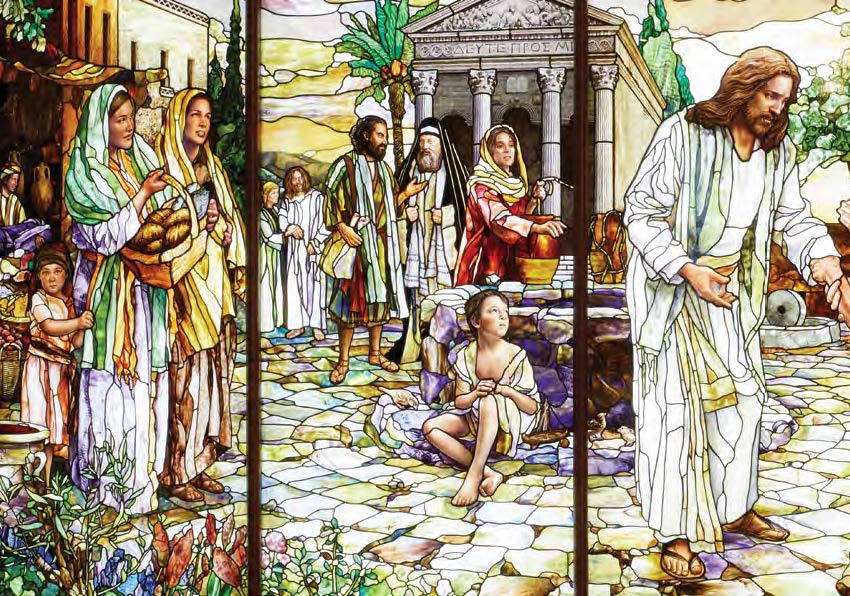
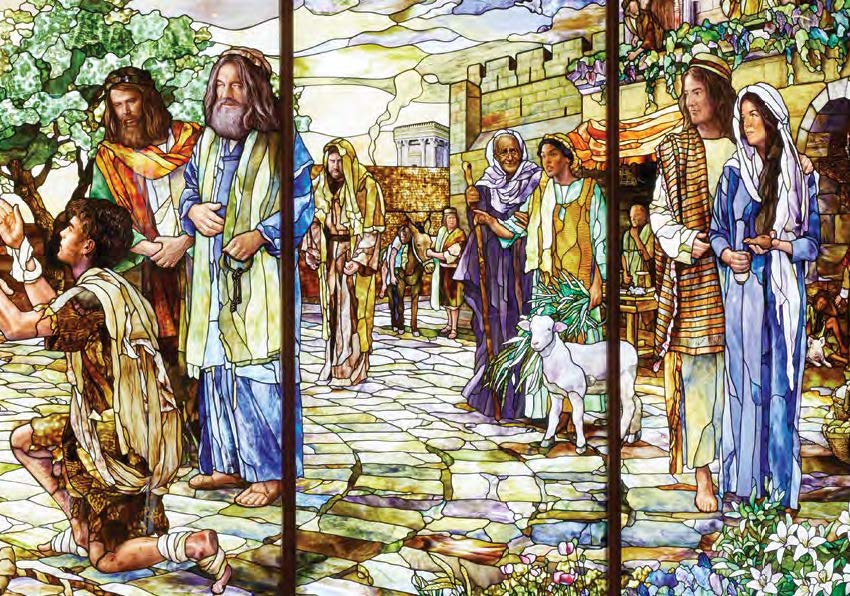
When plans to build a temple in Rome, Italy, were announced, many people in the Conference Center gasped. Tom Holdman and his wife, Gayle, were watching in their home, where Tom actually jumped out of his chair and said, “I will do that temple glass!” He has done the art glass in more than eighty temples throughout the world, but he wanted to do the Rome windows because it is such a significant place in the history of Christ’s church. Tom explained, “I feel a deep sense of gratitude to the early Saints in Rome who chose to follow Christ many centuries ago. I feel a similar gratitude for modern converts in Italy and all the missionaries who have served and continue to serve there.” Tom and Gayle and the artists at Holdman Studios not only created the approximately eight hundred art glass windows that are in the Rome temple—no two of which are alike—but they also were asked to create a twenty-by-seven-foot window for the visitors’ center.
Leaders in the Missionary Department envisioned something that would send a clear message that members of The Church of Jesus Christ of Latter-day Saints are Christians and be engaging for children and teens as well as for adults. They wanted something missionaries could use as they teach and viewers could return to repeatedly, discovering something new each time. With that goal in mind, the artists determined to depict—overtly and subtly—not only important aspects of Christ’s life, mission, and ministry but also all his parables and miracles in one cohesive image. What a challenge! The artists designed the window to present a healing scene in a hypothetical public square, but then sought help from three faculty members in Religious Education at BYU—Brad Wilcox, Anthony Sweat, and Tyler Griffin—to identify the major aspects of the Savior’s life and symbols for all his parables and miracles.
Nordgren: Tell me about how you became involved with this amazing project.
Wilcox: Tom and Gayle Holdman are longtime family friends. My mother was Tom’s second-grade teacher. When they contacted me and explained what they needed and the deadlines they faced, I knew I could not do it alone. I suggested they also reach out to Tyler Griffin, a gifted teacher of the New Testament, and Anthony Sweat from the Department of Church History and Doctrine. Tyler provided expertise about what Jerusalem and the surrounding areas would have been like during Christ’s time. Anthony, a fine artist himself, was uniquely qualified to suggest appropriate symbolic representations in the window. They both brought a rich knowledge and deep understanding of the scriptures.
Nordgren: What were some specific suggestions that you made as the project progressed?
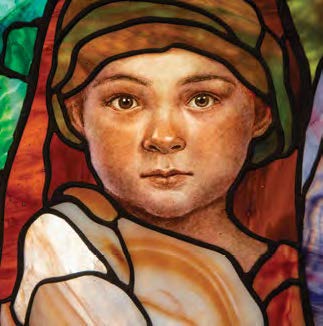 Young girl representing Jairus’s daughter who was raised from the dead. Photos by Erin Kondratieff Pritchett.
Young girl representing Jairus’s daughter who was raised from the dead. Photos by Erin Kondratieff Pritchett.
Sweat: The artists had already designed the general layout of the window but were seeking some help with content and details. I remember we had a meeting with the artists in which we went through every parable and miracle and suggested how best to represent them. For example, Tyler asked them to add the temple in the background with smoke rising from the sacrifices. He also suggested adding an olive-press stone, reminiscent of Gethsemane. I suggested adding the dark corner of a sepulcher behind the olive-press stone to suggest the tomb and Resurrection of Christ. I also wanted to see a large waterpot filled with wine to represent Jesus’s first recorded miracle. We thought adding Leonardo da Vinci’s Last Supper in the relief of the building behind Christ would be a nice touch. Tyler added “Son of David” in Hebrew at the top of another building. Brad had brought back some objects from the Holy Land and proposed they be embedded in the window to add another dimension to the art, but also to delight viewers—especially children—as they discovered them.
Nordgren: Like what?
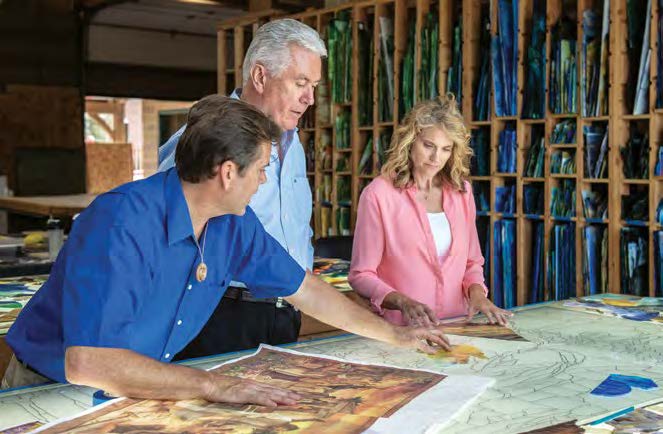 Stained glass artist Tom Holdman, with his wife, Gayle, discussing the window’s composition with Elder Dieter F. Uchtdorf.
Stained glass artist Tom Holdman, with his wife, Gayle, discussing the window’s composition with Elder Dieter F. Uchtdorf.
Wilcox: There are actual bits of frankincense among the plants to remind viewers of the gift the Wise Men brought to the Christ child. There are chunks of salt from the Dead Sea, representing the salt of the earth, and sand from the Holy Land, reminding us to be wise and not build on a sandy foundation. On the well, there are stones portrayed, including an actual rock I brought back from the Holy Land, reminding that only he who is without sin can cast the first stone. If you look at the top of the widow’s staff, you will see her mite, an authentic coin. There are also authentic coins from Christ’s time on the ground near the beggar and in the fish’s mouth. My favorite object is a shell I brought home from the Sea of Galilee that is included in the window near the toy boat at the base of the well.
Nordgren: Speaking of favorites, what are your favorite images in the window?
Sweat: Oh, man! There are too many to pick from, but one that stands out to me is the young girl in the bottom left, who represents the daughter of Jairus and also Jesus’s teachings about little children. She is looking directly at the viewer, almost breaking the fourth wall, inviting viewers to engage with her directly. She is exquisitely painted. Her face is a masterpiece. I love the grafted olive branch—bound with ties—just below the girl and the rooster to the right, reminding viewers of how Peter denied the Christ three times before the cock crowed. Each image carries so much meaning and power.
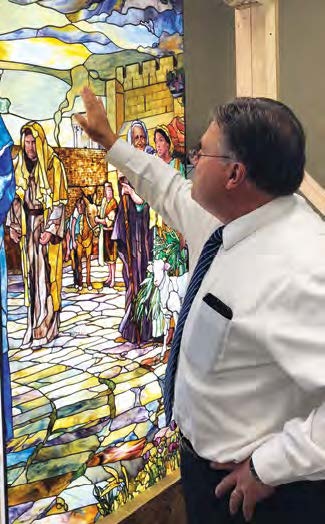 Advising scholar and author Brad Wilcox showing the rising sacrificial smoke in the finished window.
Advising scholar and author Brad Wilcox showing the rising sacrificial smoke in the finished window.
Wilcox: I love how Christ is reaching out to the beggar, who is reaching out to him simultaneously. I love how they are grasping each other, symbolizing the grace offered and received in a covenant relationship with Christ. I was there when they were posing the models and taking hundreds of pictures. In all of them, the models representing Jesus and the young man were just holding hands. Right as they were finishing, I suggested that they grasp each other. It seemed a more realistic representation of how Christ would have been lifting the young man. I was pleased when Tom and the other artists chose that very pose to be in the window. I know Tyler loves how the artists incorporated his suggestions in portraying the Apostle John. Notice the trumpets and candlesticks in his shawl, symbolizing his book of Revelation. John is also barefoot, reminding viewers of the washing of the feet and the Apostles’ willingness to be servants. He is standing next to Mary because the Savior asked him to care for her.
Nordgren: Did other faculty members participate?
Sweat: Yes. Many people helped along the way. For instance, Lincoln Blumell and his research assistant Chiara Aliberti (coincidentally from Italy) provided the Greek translation for “come unto me” on the building behind the Savior. They also emphasized the need to include the three crosses somewhere in the window since Italians coming to the visitors’ center in Rome would expect to see the Crucifixion portrayed. Similarly, they proposed that the keys in Peter’s hands be larger since that is an important symbol for Italians as well as for members of the Church. As you can see in the window, artists incorporated both these suggestions.
Nordgren: Describe the process of creating a stained glass window.
Sweat: Well, I have never created any imagery using stained glass, but I can tell you from watching the process that it is a laborious and challenging medium to master. It is much, much more difficult and costly to create an image in stained glass than in other mediums.
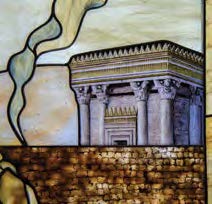
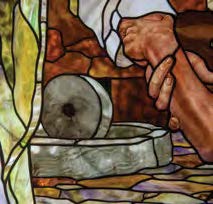
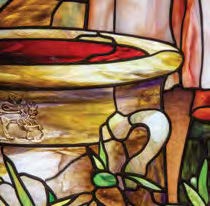
Wilcox: Each stained glass artist is an engineer, painter, and designer all rolled into one. It was amazing to watch Tom, Gayle, and the other artists at Holdman Studios in action. They had to select the glass for color and texture. Some of the textures in the window, like the basket full of bread and fish and many of the robes people are wearing, were created by layering multiple pieces of glass on top of each other. Each piece had to be cut and fit together with lead. Keep in mind that the window in Rome is curved, which further complicated an already complex process.
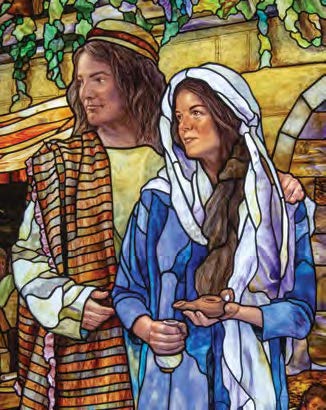 Figures representing John the Beloved caring for Mary, mother of Jesus. The female figure also represents the wise virgins in the parable.
Figures representing John the Beloved caring for Mary, mother of Jesus. The female figure also represents the wise virgins in the parable.
Sweat: The artists paint each face, arm, foot, and other details in the window. Regular paint would fade or be scratched, so they paint on the glass using finely powdered glass mixed with oils and other compounds and chemicals and fire each piece of glass to get the hues just right. Glass is fragile and breaks easily. Imagine how frustrating to spend all that time and effort painting a face, only to have it break in the firing process. They redid many of the faces in this window—including the face of the Savior—multiple times.
Nordgren: Tell me about the book that was produced.
Wilcox: Lisa Roper at Deseret Book saw the potential and helped us pull together the book called Come unto Me. Tracy Keck was our wonderful (and patient) editor. Gayle Holdman joined Tyler, Anthony, and me in authoring this volume, but it was more difficult than anyone would expect because the book and the window were being produced at the same time, and both needed to be finished in time for the temple open house and dedication. Each time the window changed, the book had to change. Each time the artists added a last-minute detail (like the roses and thorns along the top of the building on the right), the text had to be revised to match the images. We wanted to highlight the art, of course, but also to point readers to the scriptures depicted in the art.
Sweat: In addition, we wanted to provide insights to help people understand those scriptures better, make personal connections to these events in the life of the Savior, and see how the teachings can apply to us today. For example, I mentioned the Last Supper image earlier. We wrote about how in the time of the Romans the relief of a building would have typically included carvings of pagan gods. In the window, the artist purposely put the Savior and the emblems of the sacrament in place of those pagan gods, inviting viewers to do the same thing in their lives.
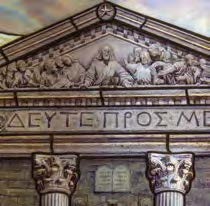
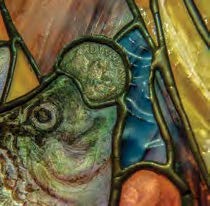
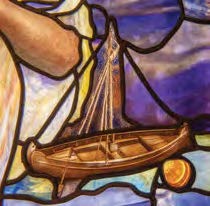
Wilcox: Each entry we wrote followed a similar structure. We introduced and contextualized the scripture. Then we discussed how it is represented in the window and how it can apply in the lives of modern disciples.
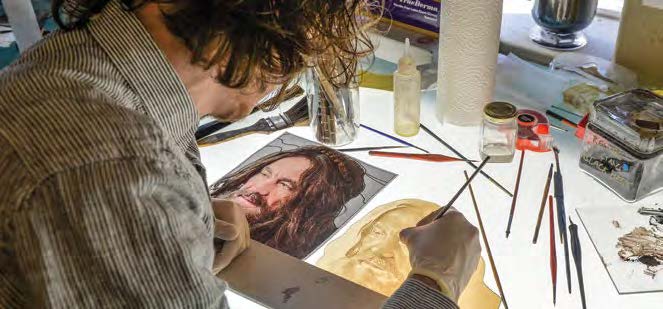 One of the many artists at Holdman Studios using liquified glass to paint a detailed head for the window.
One of the many artists at Holdman Studios using liquified glass to paint a detailed head for the window.
Sweat: We divided the scriptures and wrote entries individually. Then we swapped them with each other for peer review, revisions, and editing. We feel this approach allowed us to present various perspectives with one cohesive voice. The greatest strength of the book is its visual appeal, but our goal was to make the text equally appealing and engaging by providing thought-provoking insights that could bring the scriptures to life. Each entry in the book is presented with close-up images from the window, detailing what it is we are discussing. Our hope is that the book will allow people everywhere to feel like they are in Rome, viewing the window with us as their missionary guides.
Nordgren: Were you able to attend the open house or dedication?
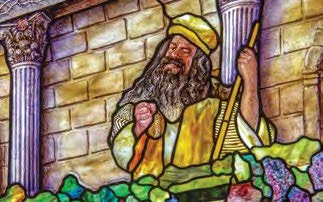 Sadducee representing hypocrisy and the parable of the fool.
Sadducee representing hypocrisy and the parable of the fool.
Wilcox: All three of us were teaching, but Tom and Gayle got to go. They were able to answer questions about the window for many of the Apostles and other special guests who came. In fact, the book was used as a gift for some of the VIPs who toured the temple and visitors’ center. It was exciting to get Tom’s text messages telling us how positively the window was received. My son-in-law is from Italy and went over to take some of his nonmember relatives through the open house. His family members were impressed with the beauty of the temple, but as they saw the statues of the Christ and all the original Apostles and the window highlighting scenes they recognized from the New Testament, they came away saying, “Now we know that you are Christians.” My son-in-law gave them a copy of the book so they could remember their experience and learn more about our witness of Christ.
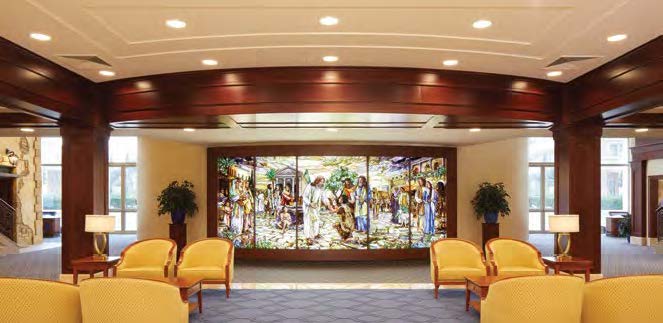 The final window, Come Unto Me, installed in the visitors’ center of the Rome Italy Temple. Photo by Cody Bell, Intellectual Reserve, Inc.
The final window, Come Unto Me, installed in the visitors’ center of the Rome Italy Temple. Photo by Cody Bell, Intellectual Reserve, Inc.
Anthony: It has been thrilling and uplifting to be a part of this amazing project. I really felt the guiding hand of the Lord throughout the entire process. I was able to take all my children to the studio and show them the completed window before it was shipped to Italy, but I recently went to see it installed in the visitors’ center there. The artists are the ones who have created something special here. Tom and his team have really given us a treasure, and they deserve all the recognition. However, it is humbling to have acted as consultants on the project and to be able to expose people to the window through the book, which has been really well received so far. It is an honor to know that BYU Religious Education is represented in a small way in this landmark work.
Wilcox: I think it shows what is possible when Church leaders, artists, and religious educators collaborate. In this case, I believe the whole is greater than the sum of the parts. Most important, it has been wonderful to be part of a project that had as its clear objective from the beginning to invite viewers and readers to draw closer to Jesus Christ.
Sweat: Yes. Christ is the central focus of this entire project. In the image, Christ is at the center of the window, and the converging perspective lines of each building point directly to him. This is what artists call the vanishing point, and in this work it purposefully but subtly points all viewers directly to the Savior. It is a wonderful reminder that he is the center of our worship and faith and that all things—including this project—testify of him.
